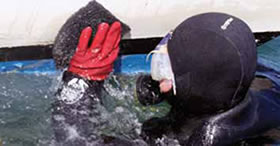
Early this month, irate boat owners from Marina del Rey, Calif., packed the regional water-quality board meeting, protesting a rule that would require them to switch to a copper-free antifouling paint by the year 2024. The board unanimously voted in favor of the rule, moving it another step forward in the legislative process-a bureaucratic cricket match that will drag on for several years.
The water board says it has no choice. The harbors daily copper loads far exceed federal standards, and filtering the water through a treatment plant will cost kazillions. The board sees copper-free paints as the least expensive remedy.
Here are the added costs (partially funded through grants) that the owner of a 40-foot boat will incur by switching paints, according to the board:
Stripping copper paint: about $6,000.
Increase in annual paint cost for copper-free blend: about $200.
Increase in hull cleaning costs: about $1,440.
The last number got me, too-$1,440 in
additional costs to clean the hull bottom? As it turns out, SoCal boaters are big on bottom scrubbing. As one observer quipped: Its as if every new boat comes with its own diving service. Sixty days after bottom-paint application (no matter how good the paint), the divers descend.
Now, we havent seen stellar results with copper-free paints, but weve seen how ePaints and some new Econea blends can go toe-to-toe or even do better than copper paints for 12 to 18 months.
Ive spoken with hull cleaners, boat owners, scientists, regulators, and paint manufacturers about this topic, and heres the picture, as I see it.
Certain California harbors have a copper problem, and recreational boats are one source.
California, where fishery management papers are churned out like Gideon bibles, also has a marine biologist problem. No faintly foul ripple goes undetected when any army of thesis-writers needs a topic.
Copper antifouling paints work longer than any alternatives, and they remain the most cost effective for the majority of boaters. They also offer the highest margins for retailers and paint makers, who don’t have to worry about the onerous EPA approval process that new formulas face.
Copper is the golden glue bonding SoCals marine triumvirate-paint manufacturers, boatyards, and hull cleaners. Hull cleaners recommend a paint, manufacturers and the yards sell the paint. Hull cleaners merrily scrub this paint into the sea, until its time to recommend the paint again.
While California is often a trendsetter, its boaters are resistant to change-and this stubbornness to kick the bottom-cleaning habit is coming back to bite them.
A new paint industry study showed how aggressive cleaning pumps 60-percent more copper into the water. Professional hull cleaners call the study bunk, saying they are careful, and are just trying their best to keep bad paints working well. This sounds to me like the first volley in a skirmish that might finally crack the triumvirate and shatter the other California dream-the dream of a cue ball-slick keel slicing through an ocean where nothing dies.





































